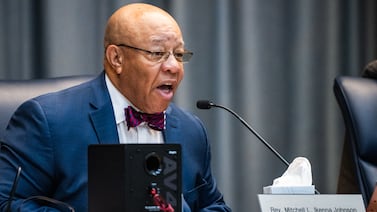Sign up for Chalkbeat New York’s free daily newsletter to keep up with NYC’s public schools.
After technical glitches prevented many families from logging in for remote learning during a snowstorm last month, officials on Wednesday presented a temporary fix: staggered start times.
The Education Department no longer cancels classes during inclement weather in part due to a growing number of school holidays and a state mandate to provide 180 days of school. As a snowstorm threatened to upend commutes on Feb. 13, city officials announced schools would operate remotely — the first citywide test of that strategy. But many families and educators encountered error messages when they tried to log in, drawing intense criticism.
During a City Council oversight hearing on Wednesday focused on the technical snafus, Education Department officials said the problem stemmed from too many users logging in at once. The city outsources the login process for its remote learning platforms to IBM, and both Education Department and IBM officials acknowledged the technical specifications in their contract did not guarantee everyone would be able to sign on during a short window.
The city is looking for a long-term solution to avoid spreading out start times, but Education Department officials said it will be necessary for now in the event of another pivot to remote learning.
“If we have a remote learning day tomorrow we should be working to stagger start times, which we agree is not ideal from a student and staff perspective,” Emma Vadehra, the department’s chief operating officer, told city lawmakers. “But it’s pretty important to us that we get it right if we do need to transition.”
Vedehra suggested that start times could be assigned by grade level and would need to be spread over a little more than one hour to ensure the sign-in process goes smoothly. Officials did not provide a timeline for coming up with a more permanent solution and some elected officials raised concerns about the approach.
“I think staggered times will be very confusing to people,” said Gale Brewer, a Manhattan city council member.
Wednesday’s hearing included the most detailed accounting yet of why families had trouble logging on for remote learning on Feb. 13. The core issue was that IBM was only contracted to handle up to 400 “transactions per second” — with one login attempt potentially using multiple “transactions,” said Scott Strickland, the education department’s deputy chief information officer. There are more than 1 million public school students and staff. (Strickland was the acting chief information officer on Feb. 13.)
In September, IBM bumped up the number of transactions per second to 1,400. As login issues mounted on Feb. 13, the day the city switched to remote learning, IBM increased the throughput to 3,000, which made the problem worse, Strickland said. The company ultimately landed on 2,000 transactions per second, which was still not enough to accommodate everyone who was trying to log in.
City officials said they did not have data on how many students and staff were unable to log in, though IBM officials said the system was “stable” by 10:15 a.m. and there were more than a million successful login attempts that day. The company has since recommended a more customized system, at an unspecified cost, that will automatically adjust based on demand.
In the aftermath of the tech glitches, city officials largely blamed IBM, a characterization the company pushed back against on Wednesday.
“We really had done everything we can to make sure that this technology was working above and beyond what it was contracted to do,” Vanessa Hunt, IBM’s senior state executive for New York, said Wednesday. “Hearing it be summarized as an IBM technology problem was, of course, frustrating.”
City officials had previously conducted practice sessions to make sure students could log in and prepared schools to distribute devices. But they did not involve IBM in those tests, Hunt said.
Hunt said she wished the city gave IBM more lead time to plan; city officials gave IBM a heads up that they planned to pivot to remote instruction at 1 p.m. the previous day, city officials said.
“Ideally, we would have been planning way before the day before,” Hunt said, adding the company now has a communication plan in place with the Education Department. “I think we would have been a part of the simulations, a part of the planning, and we would have been able to better advise the DOE on potentially staggering start times.”
Several City Council members expressed frustration that there hadn’t been more rigorous testing of IBM’s systems before the switch to remote instruction, with some casting blame on the city.
“If you have an elevator, and the elevator can only hold 1,000 pounds, and you put 7,000 pounds in the elevator, and the elevator gets stuck, is it fair to blame the elevator company in that situation?” said Queens City Council member Shekar Krishnan. “There seems to be a lot of blame, or at least passing the buck to IBM.”
At another point in the hearing, Intekhab Shakil, the Education Department’s chief information officer, seemed to acknowledge some responsibility for the technical problems. “We did not pay enough attention” to ensure that the company could quickly ramp up to meet demand during a sudden switch to remote learning, he said.
“We will work with IBM,” he added, “to ensure this does not happen again.”
Alex Zimmerman is a reporter for Chalkbeat New York, covering NYC public schools. Contact Alex at azimmerman@chalkbeat.org.





